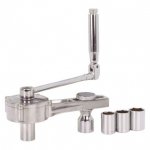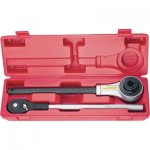I'm pretty sure (and expect to be corrected here if wrong) that regular bolts for common application should be torqued dry unless otherwise specified, because the torque value is based upon bolt stretch. However, lug nuts are a combination of bolt stretch, and more critically, the friction at the tapered seat of the nut into the wheel plate (hub). Note that the inner wheel lug nut (the "thimble") will stretch VERY LITTLE when the outer nut is applied as the length is less than 1/4" from the hub of the nut to the bottom of the outer lug nut and it's very large in diameter compared to the lug stud. The actual axle lug stud is what stretches the most.
Therefore, a minimal amount of anti-seize applied to the threads AND NOT THE TAPERED AREAS should be acceptable. The finished torque applied will be, in large part, the friction of the nut at the wheel stud hole taper.

I have found MANY TIMES that threads allowed to rust will gall and be ruined when the dry, rusty nut is turned. Preventing rust is important here.
I guess we all learned to give a torque spec to the tire shop, whatever the vehicle!

I do the same on my car--anti-sieze on the threads, none on the washer surface.
The key is to know what torque is specified--wet or dry & what surfaces are to be lubricated. Stretch may or may not be desirable, it depends on the material properties of the bolt. In general application, standard torque values are usually used to tighten the bolt to 80-90% of the yield strength, the point where the deformation of the fastener changes from elastic to plastic. Most standard torque tables found in engineering handbooks or on the web will have notes stating the conditions for which the torques are valid (no lube, clean surfaces, as new threads, & the fastener specification being typical). Most often, "stretch" becomes part of the discussion when a fastener is to be tightened enough to induce loads that cause plastic (permanent) deformation of the fastener. In these applications, the fastener is not intended to be reused.
Where reuse is required, as in lug nuts/wheel studs, the stretching of the fastener should be purely elastic and the stud will return to it's original length when the tension is removed.
In either case, it isn't really the torque that is important, it is the clamp load of the fastener that is the primary goal. Measuring the stretch of the fastener is an accurate way of determining the clamp load if the material properties are known, but usually requires specialized fasteners and/or measurement tooling. Converting preload into an applied torque is much more accessible & practical, even though it involves a host of assumptions. It is also very inaccurate. The only reason it is the preferred method in general use is because it is much easier and very inexpensive.
Others in this thread have pointed out a number of problems with the use of torque-tension relationships. Rust, thread damage/galling, galling of the washer surface, dirt, plated or unplated fasteners, all change the torque required to develop a specific joint preload. The situation gets even more difficult to manage when "wet" torque is specified. Light oil, heavy oil, grease, molybdenum disulfide, etc., etc. all have different coefficients of friction, ranging from the same as the bare fastener to 1/3rd or less.
In critical applications, it is not uncommon to build an instrumented test joint and measure torque values for a representative series of fasteners in order to come up with the torque value that is published. I would not be surprised if this type of testing was done by the manufacturer at the time the axles were designed/tested (or that the manufacturer's R&D section had done generalized testing) from which the recommendations were originally drawn.
Of course, all of the foregoing is wonderful & lovely, but it all boils down to knowing the manufacturer's recommendation, how you may have modified the manufacturer's assumptions, and understanding that things like wheel lugs are thankfully overdesigned enough to be pretty forgiving of misguided wielders of impacts.

Douglas








